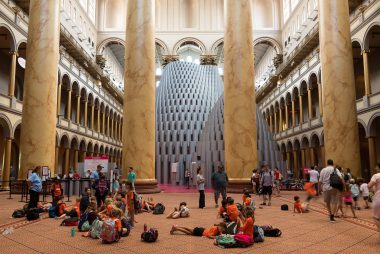Fast Company — “This Year’s Must-See Architecture Is A Mountain Of Paper Tubes”
July 11, 2017
“Every summer the National Building Museum, in Washington D.C., transforms its towering 75-foot-tall atrium into an architectural amusement park. The idea: Use crowd-pleasing, conceptually deep, installations by the world’s best designers–like Bjarke Ingels Group and James Corner Field Operations–to turn what can be a boring, dense subject into something bad ass. (Hell yes, Snarkitecture ball pit!)
This year, the museum invited Studio Gang–the National Design Award-winning firm led by MacArthur Genius Jeanne Gang–to come up with its next blockbuster. The architects proposed a 60-foot-tall interactive sonic cave composed of recycled paper cylinders, called Hive.
‘The acoustics are an important part of the installation as a way for visitors to explore the properties of architecture—material, space, etc.—but also as a way to bring together people inside the museum, to encourage intimate conversations and interactions among strangers,’ Gang tells Co.Design in an email.
Inspired by domed and arched structures both contemporary and historic—like Musgum mud huts, the Florence Cathedral, at St. Louis Arch—Studio Gang created a self-supporting labyrinthine structure out of stacked, interlocking tubes. Working with acoustic engineer John Tewksbury and percussionist Steve Bloom, Studio Gang tweaked the size and scale of Hive’s interior chambers so that the architecture would change how sound produced by human voices and musical instruments installed inside reverberates and echoes.
‘When we began visiting the museum, we noticed that the Great Hall is so vast that the sound inside is almost like being outside in the middle of a field,’ Gang says. ‘It’s such a big space that you can stand 10 feet away from someone but still not hear them clearly. We found this to be a challenge in an otherwise spectacular space. So we used materials that would change the acoustic experience and visitor’s perception of the space … We designed Hive to act acoustically like a clearing in a forest, where some sounds are reflected back and others pass through the tubes, making an intimate space in the large field of the Great Hall.’”

